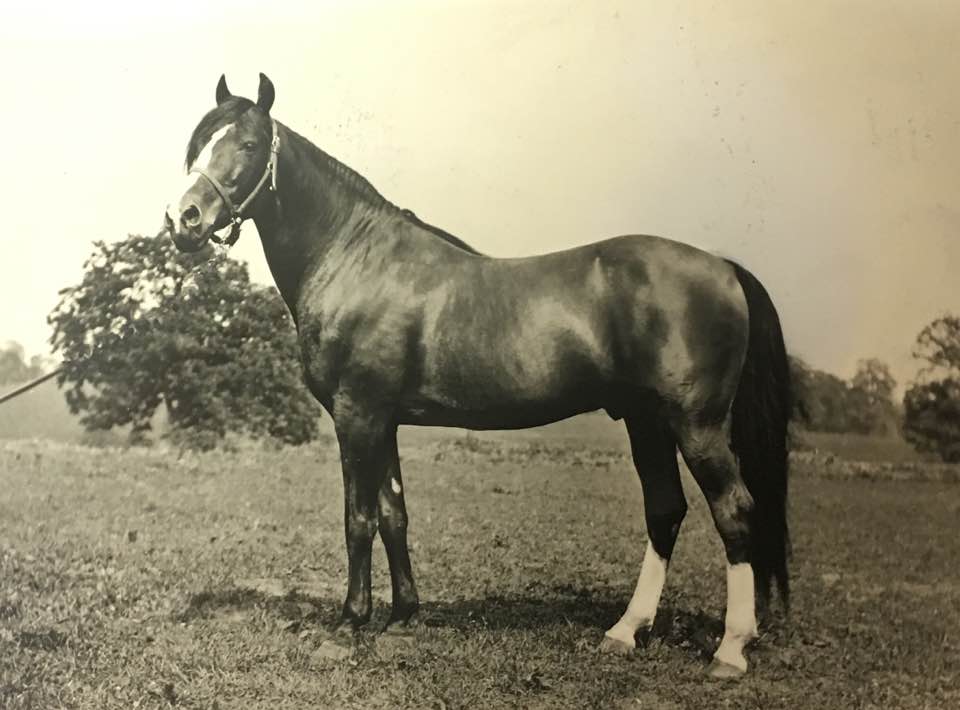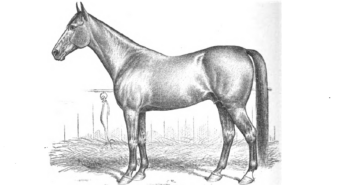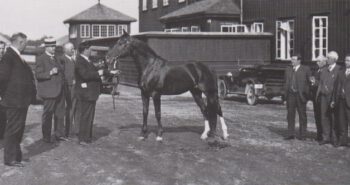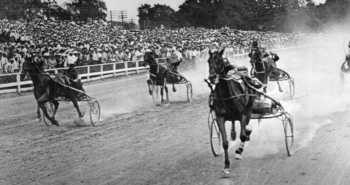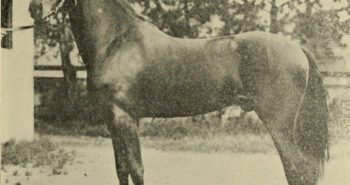Notoriously lame and struggling with unsoundness in his two seasons on the track, San Francisco was a tremendously talented trotter whose bravery and willingness to run through pain and lameness left a huge impression. In his debut, blood was dripping from his hooves with every step yet the Californian trotter finished faster than anybody else.
Born in 1903, not much is known as San Francisco until he was five. In that period he was back in Santa Ana, California with breeder, owner and trainer PW Hodges, but never entered any races. In July 1908 the colt was one of three taken to Detroit by Hodges, and San Francisco was being steered towards his debut in the M&M Stakes at the end of that month. Despite it being a fairly big race with a purse of $10,000, San Francisco was a complete unknown, and Hodges seemed to prefer it that way. In an article in the Detroit Free Press, it read “PW Hodges of Pleasanton, Cal, is at the state fair grounds with the brown stallion San Francisco, by Zombro. This fellow is in the M & M. That is all anybody knows about him, excepting Mr Hodges and the caretaker. They are as talkative as a pair of mutes when you talk about the horse (…) Mr Hodges was asked about the horse. “I have been right around fifteen with him, but that’s about all I know”, and the source of information had the lid on from that point. However, Mr Hodges had paid $500 to start him, and out west they acknowledge that he knows a thing or two.” In any event it didn’t matter as San Francisco was a late scratch in the M&M Stakes.
Hodges’ attitude had already earned San Francisco a nickname, “It was here that the white-faced stallion was dubbed the “horse of mystery” as little could be learned about him. His prospect for stake honors were not taken seriously by the horsemen at the track, and when he failed to go to the post for the M and M, they smiled to themselves and added another to their list of exploded phenomenon.” The five-year-old then appeared in the starting list for the California Stakes at the Speedway Racetrack on Aug 19, but was again a no-show come race time. By that time, Hodges was preoccupied with a much bigger race anyway, the $50,000 American Trotting Derby at Readville, MA – the richest race in the world at the time – but had a problem. Hodges had unlimited faith in his colt, but limited financial abilities. According to Ken McCarr in his article Founders of the Breeder in Hoof Beats, “Hodges did not have the $500 starting fee and he was up against a dilemma, for horses were to be handicapped shortly before the race and no one wanted to advance money on an untried horse. After seeing the horse trot three quarters in 1:34, JH Brown of Detroit became interested but would not agree until he had seen San Francisco work in 2:08 3/4 / 1.20,0 with the last quarter in 30 seconds. He then produced the entry fee with the agreement that he was to get a percentage of the winnings.”
The $50,000 handicap at Readville, later referred to as the American Trotting Derby was announced on April 1st 1908, but was no joke: the purse of $50,000 was the largest ever in the US at the time and colonel John Eliot Thayer was so enthusiastic about the race that he even guaranteed for it. The race was to be a handicapped one-heat dash over 1 1/4 miles. Horses would receive a handicap of 50 feet (15,24) meters for each second their record was faster than 2:15 (1.23,9). The winner would receive $30,000, second $10,000, third $5,000, fourth $2,500, fifth $1,500 and sixth $1,000, with fees of $100 to name on May 15, sustaining fees of $100 on June 15 and July 15, as well as a $200 fee on Aug 22. Pretty much everything about the race was fresh and exciting; the purse was higher than anything seen before, the distance was unusual, the order of the day was heat racing and handicapped races were virtually unheard of in the US. The latter was picked up from European racing, “the handicap system calls for a standing start, which is a novelty on this side of the water. American horses raced abroad takes to the change in starting very readily and seldom do they bother or get disqualified at the start. American trainers in Austria are loud in the praise of the distance handicap system of racing, and are constantly writing to people in this country urging that a trial be given this plan.”
Trotting his heart out
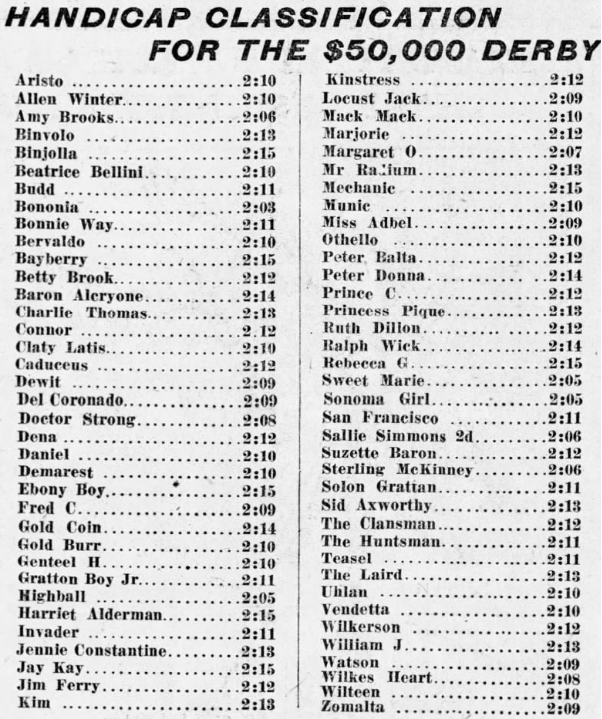
72 trotters were initially named to the handicap, and in the end 38 started. This meant two eliminations of 19 trotters each on the mile-long Readville track. Rated at 2:11 (1.21,4), San Francisco had a distance of 6600 feet to run, 200 more than Binjolla and Rebecca G, but 300 less than elimination favorite Sweet Marie. The latter, a 2:02 (1.15,8) daughter of McKinney, was an incredibly fast mare who had won 22 of 24 races in 1906 and 1907 and held numerous world records. The long handicap and big field to circle around was too demanding for the mare, however. She made the final, courtesy of an 8th place finish in her elimination, but finished out of the money in the final. San Francisco finished fifth in his elimination and improved on that in the final when he finished strongly but had to settle for third honors as he was nosed out for second. The horse wasn’t helped by the overweight Hodges’ relatively poor driving skills which caused the colt to travel a much longer distance. It was still one of the most impressive third-place finishes in history, and San Francisco left drops of blood all over the field to prove it.
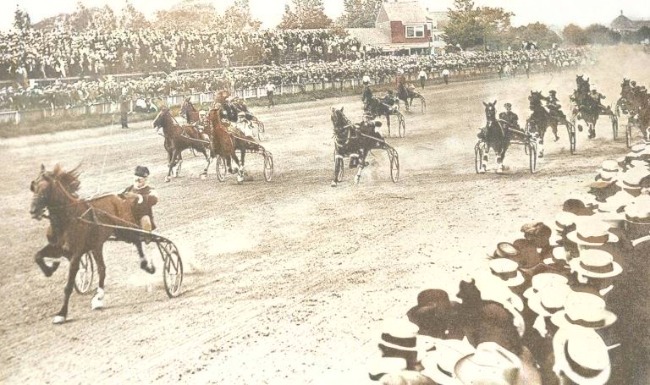
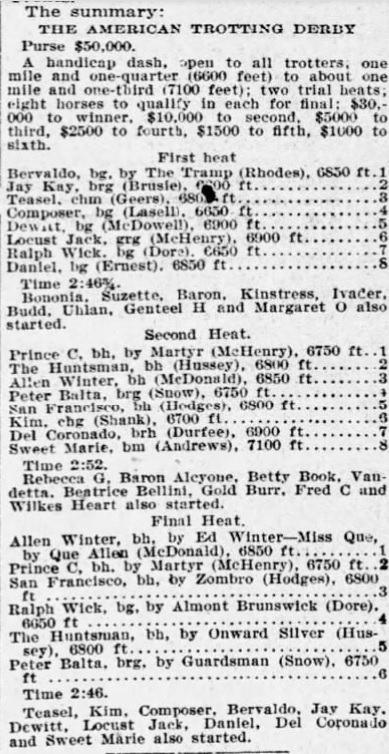
According to Charles C. Marshall, Jr. in his article Never Say Die; The Story of San Francisco in Harness Horse, “the packed and struggling field were battling it out in a bunch at the head of the stretch, a powerful, white-faced trotter going the widest of all to find racing room. In close to the rail, Allen Winter boomed through to an open length lead and hung on to win by a safe margin. The race was the mile and a quarter $50,000 Trotting Derby at Readville, Mass., in 1908, second place going to Prince Direct by inches, as he luckily slipped through on the rail, saving much ground. The white-faced charger was none other than the warhorse San Francisco the third horse in the mammoth field, making the first start of his life. Horsemen were unanimous in their praise of the valiant son of Zombro 2:11 (1.21,4) that day. Apparently hopelessly out of contention in the marathon grind, forced to race practically in the center of the track, he made up a world of ground and was going strongest of all at the close, racing like a veteran. Such an exhibition of gameness on the part of a sound horse would have been quite enough reason for praise, but San Francisco was definitely not in that category. The California-bred stallion, then a five-year-old, raced with his front feet in such terrible condition, both from severe contraction and a serious quarter crack, that his hoof prints on the track were literally flecked with blood. Nevertheless, he was always on his stride, remarkably even-gaited, and resolute to the end. Unlike many widely admired trotters, that earn their reputations through sparkling victories, the glory of San Francisco was won in defeat.”
Lameness
Hodges and Brown weren’t quite willing to accept defeat silently. Later in August they challenged the owners of Allen Winter, Prince C, The Huntsman and Sweet Marie for a rematch where each team would put $2,500 on the table for a winner-take-all three in five heats at Readville in early September. Will Andrews, driver and manager of Sweet Marie, accepted immediately while the owners of Prince C and The Huntsman declined, claiming it was too hard. Allen Winter’s owner Michael Reardon answered in the positive, but then San Francisco had to pull out it. When the colt started in the 2:14 trot at the end of August, he barely lasted one heat: “San Francisco, the horse they wanted to race against Sweet Marie and Allen Winter, came onto the track lame and was excused after the first heat. This means that the proposed three-cornered affair is off, which is a pity, as Sweet Marie and Allen Winter were ready to race.”
San Francisco only made four more starts that season and won one of them, the only triumph of his racing career. At the end of September, the California-bred trotter finally got his first, and only, win when he won all three heats of the Hoster-Columbus consolation Trot, winning in 2:07 3/4, 2:07 3/4 and 2:09 1/4 (1.19,4, 1.19,4 and 1.20,3) at the Columbus track. Newspaper reports note how the colt showed strong finishes in all heats but was still struggling with lameness. An article in the St Louis Globe-Democrat at the end of 1909, summing up his career, stated that San Francisco “won a corking good race, taking his record in 2:07 3/4 (1.19,4) in spite of being very lame.” At the same track a few days later San Francisco was the favorite in the Buckeye. However, the talented trotter had to settle for fourth place and wasn’t closed to winning as he finished 4-4-3. For the colt to even do that well seems to have been a reflection of his tremendous gameness and ability to overcome his problems. According to newspapers reports “San Francisco was very lame in the shoulder and was never in the hunt.”
A remarkable comeback
San Francisco came back impressively in 1909. He didn’t win, but put in numerous magnificent performances. His seasonal debut at Kalamazoo on Aug 2 saw Lady Jones win relatively easily while San Francisco had to settle for fourth after heat placings of 3-3-2-4, despite being close in the first three heats. Eight days later at North Randall, Cleveland, the Californian colt lost both heats to Uhlan but pushed the latter all the way. The second heat was won in 2:03 3/4 (1.16,9) and San Francisco trotted in 2:04 (1.17,1), losing by a head after putting in a valiant effort on both occasions.
Four days later, on Aug 14, San Francisco started in a time trial with Ed “Pop” Geers, the most famous driver of the time, up. The goal was to beat Cresceus’ trotting stallion record of 2:02 1/4 ( 1.16,0). After a slow start, 32 1/4 at the first quarter and 1:04 at the half, it was really impossible. San Francisco put in a really strong finishing, getting to the three-quarter pole in 1:35 and finishing in 2:04 3/4 (1.17,5). The time would never be San Francisco’s record, however, as the rules of the day stipulated that the horse had to beat the time it was set up to beat. Had Hodges and Geers specified the horse had to beat 2:05 (1.17,7), the time trial mark would indeed have been his new record time. Just five days later, which meant San Francisco and his poor feet started three times in only nine days, he was unable to stay trotting at Fort Eerie. The colt then went back to Readville for the second edition of the American Trotting Derby. As Uhlan was scratched because of his upcoming duel with Hamburg Belle, San Francisco had the biggest handicap courtesy of his 2:08 rating. This proved his undoing; “Sonoma Girl and San Francisco, from the scratch, had trotted a wonderful race, but the wall of horses in front prevented them from getting into the front rank at the finish.” In the end, San Francisco finished seventh in the final.
After six starts in August, San Francisco was given two weeks off but returned at Syracuse on Sep 15th. Despite being the favorite, the son of Zombro had to settle for fourth after finishing fourth in both heats, the gelding Paderewski, a son of Constanero, winning both heats. The latter won again in Columbus on Sep 24, but was pushed to a new three-heat world record by San Francisco who finished a very close second in all three heats. Paderewski won in 2:05 1/4, 2:06 3/4 and 2:05 1/4 (1.17,8, 1.18,8 and 1.17,8).
In the McDowell Stake at Lexington on Oct 12, San Francisco broke at the start of the first heat, but put in an exceptional performances when he rounded the field and barely lost to the magnificent The Harvester. In the second heat the seven-year-old stayed on gait but again had to settle for second. In the third heat of the best-of-five race, The Harvester lost the third heat to Lady Jones while San Francisco again finished second. After the heat, The Harvester was found to be sick and withdrawn. In the last two heats Lady Jones beat San Francisco and won the whole race. San Francisco thus had the unenviable record for finishing 2-2-2-2-2. A third-place in the handicap race The October Prize at Lexington only three days later was to be San Francisco’s final start, though that was not known at the time.
Walnut Hall
At the end of the year, the then six-year-old colt was sold to Walnut Hall Farm. From an article in the Breeder and Sportsman, “Mr L.V. Harkness, proprietor of the famous Walnut Hall Farm, at Donerail, Kentucky, has purchased from PW Hodges company, for $15,000, the trotting stallion San Francisco 2:07 3/4 (1.19,4), by Zombro 2:11 (1.21,4), dam Oniska, by Nutwood Wilkes 2:16 1/2 (1.24,8), second dam Bay Line by Direct Lane, son of Director. San Francisco was bred by PW Hodges, the well known California trainer, who bought the dam Oniska for $275 to be paid for in training bills. He sent Oniska to Zombro and got a foal that he trained and raced in 1908 to a record of 2:07 3/4 (1.19,4) and also trotted him a mile in public this year in 2:04 3/4 (1.17,5). San Francisco is without doubt one of the fastest living trotters and is capable of lowering his record if prepared for a flight against the watch. He is a remarkably game horse and can go as many heats in fast time as any horse that appeared this year. Mr Hodges’ many friends in California will be glad to hear that he has received a good price for San Francisco and hope that Mr Harkness will give the stallion an opportunity to reduce his record further before retiring him permanently to the stud.”
The reports at the time specified that San Francisco was to be mated to a number of mares the following spring, before being trained and raced with a view of giving him a faster record. In the spring of 1910 it was reported that San Francisco would be trained by Edward Benyon at the conclusion of the breeding season. That never materialized, however, as San Francisco remained in the stallion ranks. San Francisco was for many years one of the key stallions at Walnut Hall Farm, but didn’t get too many mares. His best performers were the Kentucky Futurity winner Mary Putney 2:04 3/4 (1.17,5), the ill-fated Fireglow 2:04 (1.17,1), Sanardo p1:59 1/2 (1.14,3), Lu Princeton 2:01 (1.15,2), Saint Frisco 2:01 3/4 (1.15,7) and Vansandt 2:00 3/4 (1.15,0). Lu Princeton sired the double Prix d’Amerique-winner Hazleton, but the sireline didn’t last for many generations. San Francisco is still a fundamental stallion in trotting history as the gameness he displayed was cemented in the breed through two key descendants: Volomite, where San Francisco is the damsire, and Star’s Pride, where he is the damdamsire.
San Francisco died at Walnut Hail in 1934. When his death was reported, the Lexington Herald-Leader commented that “San Francisco was outstanding in harness horse breeding.”
San Francisco
Bay colt born in Pleasanton, CA in 1903. Died in Lexington, KY on Mar 8, 1934.
Zombro – Oniska (Nutwood Wilkes)
Fastest win: 2:07 3/4 (1.19,4) – Fastest time: 2:04 (1.17,1)
Breeder: PW Hodges
Owners: PW Hodges – Walnut Hall Farm
Trainer: PW Hodges and “Pop” Geers
Drivers: PW Hodges and “Pop” Geers
Groom: –

